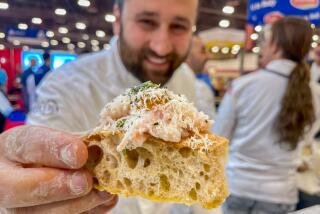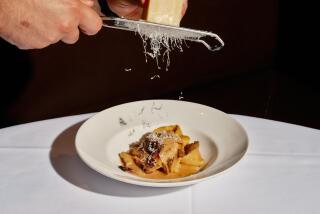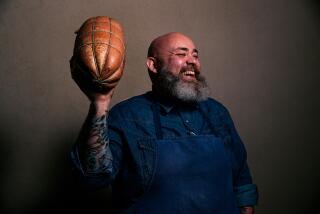New Pasta Ideas Taking Shape : Cooks Use Their Noodle to Pick the Right Product
Buttons, bows and butterflies.
You name it, and you’ll be able to find fresh and dry pasta in any one of dozens of shapes, sizes and even colors these days. Packaged dry pasta is available in a limited number of fanciful shapes in any supermarket. However, most Mediterranean food stores carry greater varieties of shapes of dry pasta, most of it in loose form sold by the pound.
Some fresh pasta outlets sell as many as 15 different shapes of fresh pasta, and supermarkets also provide several varieties on their deli shelves. The pasta sold in stores specializing in pasta is generally made daily but have a shelf life of up to 10 days under good refrigeration conditions. Ideally, for best results pasta should be purchased the day you plan to use it.
Supermarket-fresh pastas have a shelf life of up to two months, due to pasteurization and storage in a nitrogen-controlled atmosphere packaging, according to Al Resnick, president of the Coronet Brokerage Co. in Los Angeles, which handles Santino fresh pasta, one of the brands distributed to supermarkets. Pasteurized pasta can also be frozen. However, the recommendation to keep all fresh pasta refrigerated unless frozen, is also a warning that pasta is highly perishable because of its raw egg content and should be used within a day or two of purchase, despite the shelf life advisement. Furthermore, the fresher the pasta, the better the taste and nutritional quality of the product.
Cooking Instruction
Follow cooking directions on the package when cooking pasta, remembering that pasta tends to cook further after it is removed from the cooking water. Fresh pasta will cook within one to three minutes, depending on the brand and shapes used. Atmosphere-controlled fresh pasta tends to be slightly more al dente than freshly turned out unpasteurized pastas.
Dry pasta cooks from eight to 15 minutes, depending on the shape and size used. Dry pastas made with 100% durum wheat will cook more al dente than pasta made with other or partial durum wheat flours. The longer the cooking the more tender and pasty the product will become.
Once cooked, pasta should be handled quickly and served at once. For extra al dente pasta, tasting a few strands short of the prescribed cooking time will tell you if it is ready to eat. The pasta will be chewy to the bite, and perhaps even slightly raw in the center.
Thorough Draining Necessary
Rinsing is unnecessary, although some cooks prefer to rinse starch out of pasta. The tendency, however, will be for the pasta to become slightly watery unless thoroughly drained.
Here is a glossary of pasta shapes--with translations of the Italian names--taken in part from a National Pasta Assn. bulletin. Most of these varieties can be found in either dry or fresh form in local markets.
Agnolotti-- Round ravioli filled with meat or other filling shaped like turnovers.
Anelli (rings)--Small ring-shaped pasta often used in soups and salads.
Bucatini (small cave)--Long hollow macaroni, but thinner than spaghetti.
Capellini d’Angelo (angel hair)--Delicate long, thin threads of pasta.
Capelletti (little hats)--Shaped dumplings usually filled with minced chicken or meat.
Cannelloni (large tubes)--Tubes of pasta for stuffing.
Conchiglie (shells)--Shell-shaped pasta that comes in various sizes; small ones for soups and salads, large ones for stuffing.
Ditalini (little thimbles)--Small tubular macaroni cut short and often used in soups.
Farfalle (butterflies)--Pasta shaped like bows or butterflies with fluted edges.
Fettuccine (small ribbons)--Pasta shaped like long ribbons.
Fusilli (twisted spaghetti)--Long strands of spiraled spaghetti or corkscrew-shaped.
Gemelli (twins)--Two short pieces of spaghetti twisted together.
Lasagna (from lasanum, Latin for pot)--Flat, broad pasta with ruffled edges.
Linguine (small tongues)--Narrow flat strands of pasta.
Manicotti (small muffs)--Large, long tubes that are usually stuffed.
Mostaccioli (small mustaches)--Large macaroni with a ridged or plain surface; ends are cut diagonally.
Orzo (barley)--Resembles rice in size and shape, and is often used as a rice substitute. Also known as chicci di riso.
Pastina (little pasta)--Tiny pasta shapes used in soups.
Penne (quill)--Hollow pasta cut on a diagonal like a quill pen.
Perciatelli (small and pierced)--Long, hollow macaroni rods somewhat thicker than spaghetti.
Ravioli-- Pasta squares stuffed with various fillings.
Riccie (curly)--The name applies to several pastas that are ripple-edged, such as lasagna riccie, fettucce riccie.
Rigatoni (large, grooved)--Grooved macaroni that is slightly curved and used with or without stuffing.
Rotelle, Rotini (spirals)--Spiraled pasta about 1 1/2 inches long.
Ruote (wagon wheels)--Die-cut shapes that resemble wheels.
Spaghetti (from the noun spago, meaning length of string)--Long, thin strands of pasta that come in various widths.
Spaghettini (narrow spaghetti)--Long strands that are thinner than spaghetti.
Stellini (little stars)--Tiny pasta shaped like stars, often used in soups.
Tagliatelle (to cut)--Similar to fettuccine, but slightly broader.
Tagliolini-- In the family of tagliatelle cut slightly thinner.
Tagliarini-- Cut even thinner than tagliolini.
Tortellini (small twists)--Pouches of dough that are stuffed and ends folded over.
Tripolini (little bows)--Bow-shaped pasta named in honor of the conquest of Tripoli.
Tubetti (tubes)--Tiny macaroni often used in soups.
Vermicelli (little worms)--Thin strands of spaghetti, sometimes in solid clusters.
Ziti (bridegrooms)--Tube-shaped pasta that resembles macaroni.
Zitoni (husky bridegrooms)--A larger version of ziti.
More to Read
Eat your way across L.A.
Get our weekly Tasting Notes newsletter for reviews, news and more.
You may occasionally receive promotional content from the Los Angeles Times.










